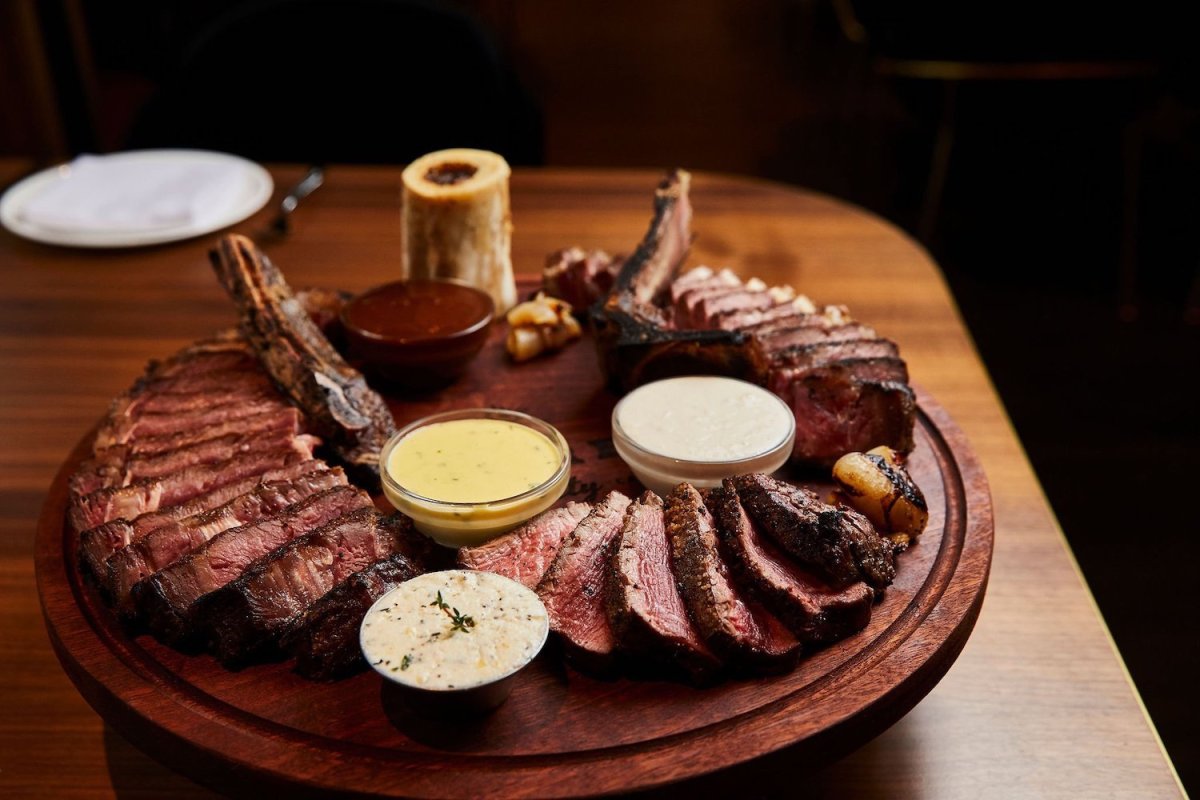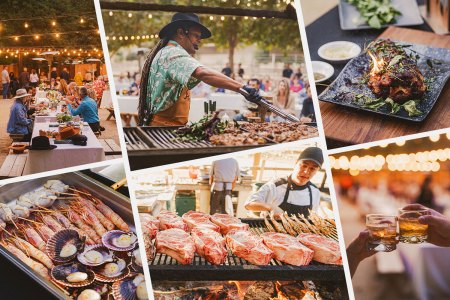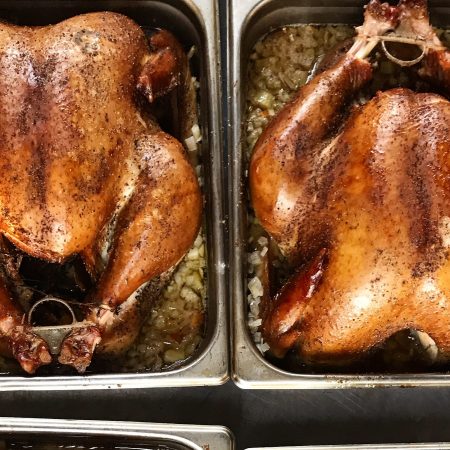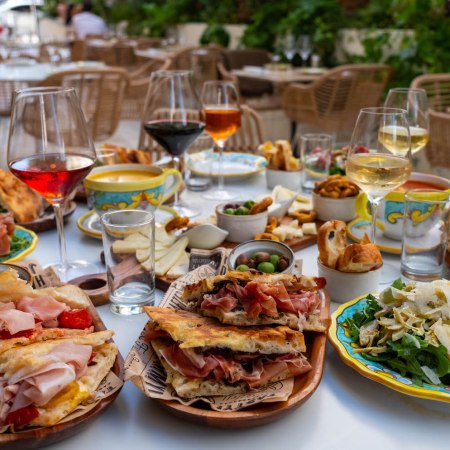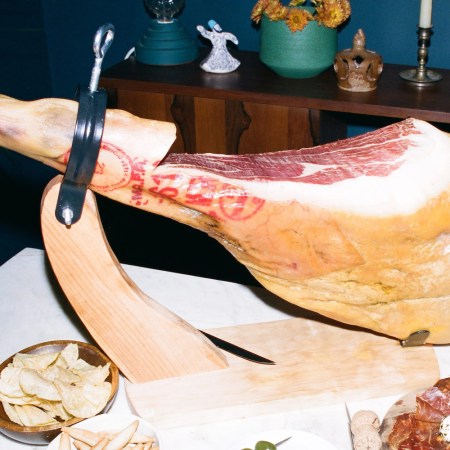Cheese and charcuterie boards are tired. Fanned out apple slices, artistic smears of butter and flower petals of pepperoni have become so ubiquitous, it takes a little creativity to get beyond the status quo. To turn up the heat at your next gathering, you need something heartier, meatier even. Why not bring your grill game into the mix and join the world of steak boards?
Chef Brad Wise, founder of Santa Barbara steakhouse Rare Society, has been serving shareable steak boards with various cuts in his restaurants to much success, and he might just be onto a new trend. “These boards are presented on a custom-made lazy Susan right in the middle of the table, so the boards drop, and you can spin it and sample each cut of meat,” Wise says. “This shared style of dining is at the core of our hospitality ethos. This is an everyday restaurant that serves our interpretation of a steakhouse.”
Wise is confident that most home chefs can pull this off in their own kitchen, too. If you’re not in the Santa Barbara area — or near one of his other locations — then assembling a shareable steak is a great project for a weekend dinner party or weeknight splurge. Start with the most important element: sourcing. “Utilize your local butcher,” Wise says. “Find a good one and start to build a rapport. The quality at a butcher’s shop can’t be beaten.”
How to Grill
Before you get the meat on the grill, it must be seasoned properly. Wise recommends letting the steak come all the way to room temperature before seasoning. “I always use the following formula: 50% salt, 10% pepper, 30% granulated garlic and 10% parsley,” he says. “Drizzle oil over your steak first. This will do two things — it helps the seasoning stick to the meat better, and it creates a better crust. Then rub the seasoning onto the meat, and let it sit out for anywhere between 15 to 30 minutes.”
Setting up your grill with multiple temperature zones is his next bit of guidance. “When it’s time to cook, you’ve got to create heat zones in your grill so you can cook on high and low heat,” he says. “Use a combination of both heat levels to cook your steaks. For this board, sear everything first and then move it over to a lower zone.”
Chef Govind Armstrong on the Strangest Things He’s Ever Grilled, Including Beaver Tail
Plus: An oxtail recipe for the ambitious home chefWhat to Grill
Basing his recommendations pretty squarely off the boards served at Rare Society, Wise suggests three main cuts: tri-tip, Denver steak and filet mignon. “For those who aren’t familiar with tri-tip, it’s a triangular piece of meat (hence ‘tri’) that comes from the bottom (or ‘tip’) of the sirloin,” he says. “This is the classic cut you’ll see at all the Santa Maria BBQ joints. I love it because it’s a value cut — I can feed a whole crowd without breaking the bank.”
When cooking at home, Wise sticks with a cut from his preferred domestic ranch, Gold Canyon Angus, and also throws in “some sort of seasonal roasted vegetable, grilled bread, salsa and a Central Coast pinot noir to complete the meal.”
How to Slice the Meat
The whole point of a shareable steak board is to present the meat on the board, so make sure you have one cutting board for slicing and one for presenting. The next most important thing to remember is to let the meat rest. “Rest time is extremely important,” Wise says. “Commit to a minimum of four minutes for each steak after it comes off the grill. This will ensure your meat is tender, juicy and way better.”
After the steaks have rested, the perfect slice is achieved by going against the grain. “Make sure to cut thin slices against the grain and pivot your cuts as the meat changes direction,” Wise says. “This last step is what is going to make a good steak great. Slicing it right, against the grain, this could make or break your meat board .”
Sauces to Serve on the Side
Now that your meat is curated, cooked and sliced, it’s time to assemble the accouterments. If you’re going with tri-tip, you want a salsa to complete the Santa Maria-style spread. It’s what the Spanish vaqueros put on their steak in the mid-19th century, and the tradition just stuck.
“This is the classic ‘vegetable’ that’s generally served with tri-tip in the Santa Maria style,” Wise says. “Buy any heavy tomato-based, chunky salsa and serve it on top of the sliced tri-tip. Salsa on top of tri-tip is a tradition along the Central Coast. It’s never too hot or sweet, just a well-balanced salsa that helps cut through the richness of the steak.”
Then again, there’s always butter. Compound butters are made by adding ingredients to butter, so it has more flavor and just feels fancier. “It melts onto the meat, which basically turns into a sauce,” Wise says. “There are no rules for making a compound butter, so you can experiment with all sorts of different ingredients — salt, lemon, garlic, shallots, herbs, vegetables. Everything you layer into it just makes it that much better and stronger.”
Here’s a recipe for compound radish butter to get you started. That Instagrammable, perfectly sliced, shareable steak board is just a few hours of grilling and prep time away.
Compound Radish Butter
Servings: 2 cups
Ingredients
- 1 lb. butter
- .75 cup blended radishes
- 1 Tbsp. lemon juice
- 1 Tbsp. minced garlic
- 1 Tbsp. kosher salt
Directions
-
-
Puree the radishes in a blender until smooth. Bring the butter to room temperature. Mix the butter in a stand mixer using a paddle attachment. Fold the remaining ingredients in with the butter. Transfer butter to an airtight container and keep refrigerated for up to one month.
-
Join America's Fastest Growing Spirits Newsletter THE SPILL. Unlock all the reviews, recipes and revelry — and get 15% off award-winning La Tierra de Acre Mezcal.
